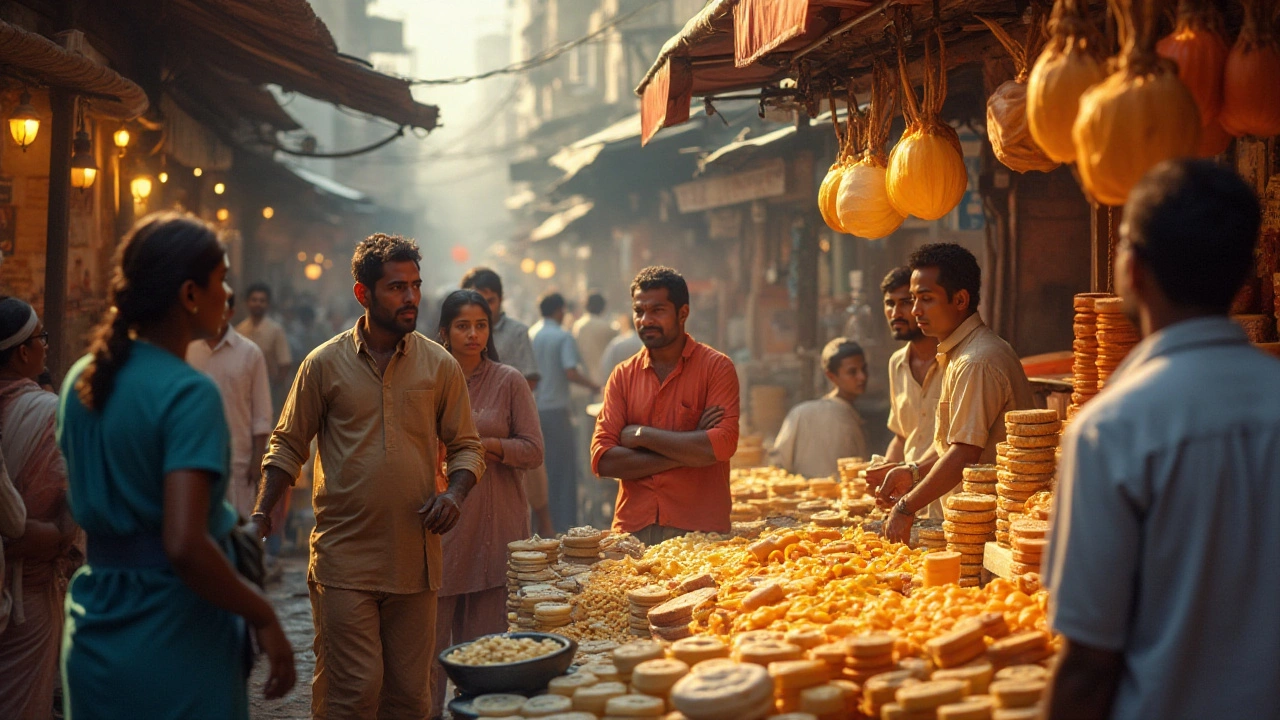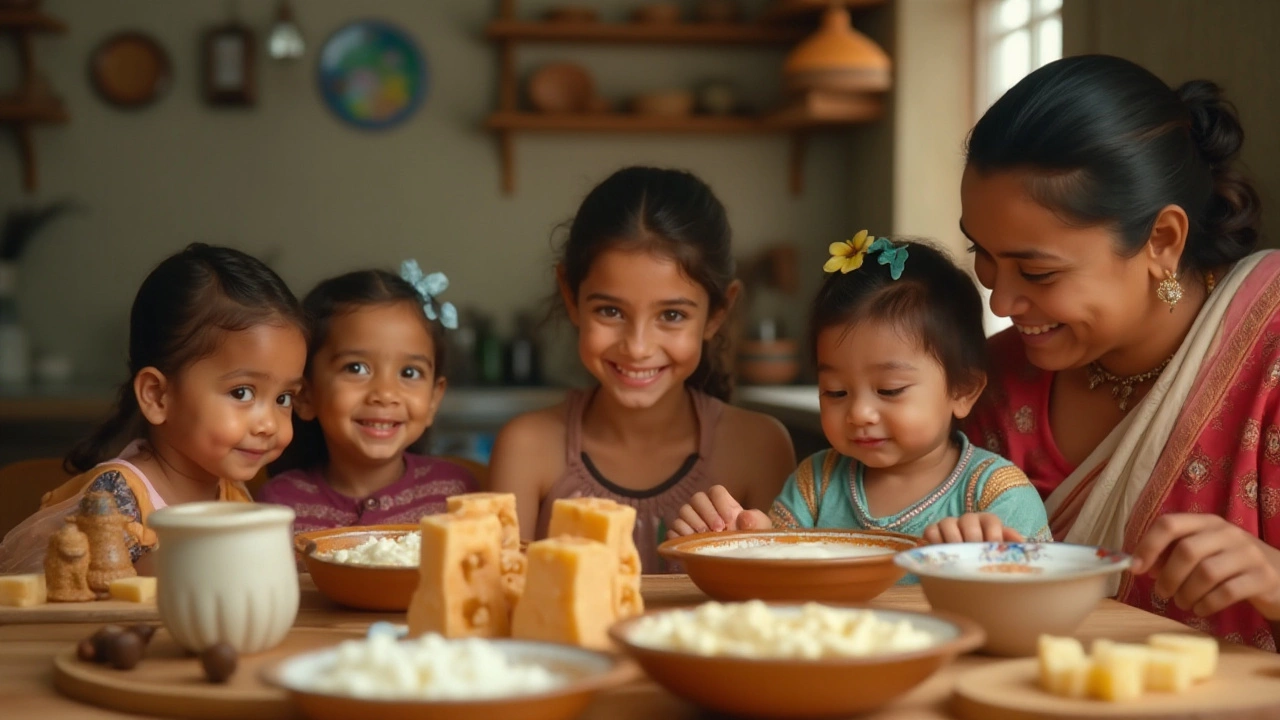Cheese often finds itself overshadowed by other dairy staples in the diverse tapestry of Indian cuisine, particularly in breakfast spreads. This might seem surprising, given cheese's prominence across global palettes. However, Indian breakfasts, rich with tradition and regional diversity, have historically leaned towards alternatives like paneer and curd.
In many Indian homes, breakfast is not just a meal but a daily ritual that resonates with cultural and familial bonds. The inclusion of cheese is somewhat like a cameo appearance, yet to conquer the starring role. A deep dive into the historical layers of Indian culinary practices and local preferences can shed light on this culinary peculiarity.
Yet, the global cheese wave is gradually sweeping across India's urban landscapes, blending seamlessly with the country's evolving food culture. Understanding where cheese stands today requires not just an exploration of taste but a journey through history, nutritional insights, and innovative ways to enhance daily meals with this versatile ingredient.
- Cultural Roots and Dietary Habits
- Presence of Indigenous Dairy Products
- Influence of Globalization and Urban Trends
- Nutritional Perspectives
- Tips to Incorporate Cheese in Indian Breakfasts
Cultural Roots and Dietary Habits
India's culinary identity is a fusion of its multifaceted culture, which celebrates diversity and tradition in every aspect, from language to food. The country's dietary habits are deeply embedded in its cultural roots, where traditional meals are more than mere sustenance; they are symbolic of community, faith, and history. The subtle art of cooking is often passed down through generations, binding families and communities with recipes as unique as each individual's tapestry. Historically, Indian breakfasts reflect regional specialities ranging from the spiced parathas of the North to the rice-based idlis in the South. These meals are designed to be nourishing and cooling, often incorporating locally grown ingredients that not only satiate hunger but balance the climate's heat.
Cheese, though a cornerstone in Western breakfast cuisine, does not have the same footprint in India. Its absence can be attributed to the dominance of local dairy products such as paneer, which is more deeply woven into the fabric of Indian cooking. Paneer has been a celebrated ingredient in Indian dishes for centuries, known for its versatility and ability to absorb flavors. The distinction between cheese and paneer is paramount — while cheese involves a process of aging and the addition of cultures, paneer is fresh cheese, made daily in many households without additives. This simplicity accords it a naturally superior acceptance in homes where tradition is cherished. Beyond paneer, dairy products like milk, curd, and buttermilk play significant roles, fulfilling dietary needs with their probiotic properties that help in digestion, especially crucial in a spice-rich diet. In an intriguing twist, globalization has gently nudged cheese into modern Indian kitchens, where it is now being experimented with alongside traditional staples. Yet, for many, it lacks the heritage that indigenous dairy products carry.
The relationship between Indian dietary habits and cultural dynamics extends beyond what is consumed to how meals are experienced. Breakfast in India is as varied as its people, yet it is often enjoyed with the family, setting a tone of unity and prosperity for the day. In some parts, lavish breakfast spreads are linked with religious practices or seasonal festivities, bringing communities together in celebration. Understanding these traditions illuminates why Indian culinary practices, traditional dairy consumption, and modern additions form an intricate mosaic reflecting both historical loyalty and openness to change. From an outsider's perspective, cheese may seem just another ingredient, but within Indian kitchens, it dances on a different note — an echo of contemporary influence against a backdrop of enduring traditions.
Presence of Indigenous Dairy Products
The Indian subcontinent boasts a rich history when it comes to dairy products, each playing a monumental role in the daily diet of millions. Central to this tradition are items like paneer, curd, and lassi, all deeply woven into the fabric of Indian meals from breakfast to dinner. Paneer, known for its versatility, is often compared to cottage cheese but offers a unique taste and texture that seamlessly melds into Indian cuisine. This staple isn't just a cooking ingredient; it's a protagonist in countless dishes that brighten up a typical breakfast table in India. Spongy and fresh, paneer transforms into delicious fillings for parathas or star players in spicy curries, appealing to diverse palates across regions.
Curd, or yogurt, is another exceptional favorite, making its presence known in the form of buttermilk or simple dahi, enjoying immense popularity due to its cooling properties. It's widely believed to aid digestion, making it an indispensable part of a hearty Indian breakfast. From helping to beat the heat to acting as a base for savory dishes, curd's adaptability is unmatched. Additionally, lassi—a sweet or salty yogurt-based drink—not only refreshes but also satisfies nutritional needs with its rich calcium content. Distinct from Western interpretations, these indigenous dairy products offer a complex flavor profile cherished across generations.
India's dairy industry is also thriving, reflecting traditional roots but rapidly adapting to contemporary demands. According to FoodNavigator-Asia, India is the world's largest producer and consumer of milk, underlining the massive reliance on locally crafted dairy goods over imported alternatives like cheese. Paneer alone constitutes a significant portion of the country's cheese market, emphasizing a preference deeply rooted in cultural habits. Perhaps this resistance to global cheese stems from a robust sense of identity retained through its indigenous products, embraced proudly at local dining tables nationwide.
Despite the allure of international cheese varieties, many Indians remain steadfast in their love for native dairy produce. This preference could also be attributed to dietary and climatic factors—dairy options like curd and buttermilk thrive in tropical climates, offering relief and essential nutrients. For a country where vegetarianism is prevalent, these local dairy choices provide crucial proteins and fats. They imbue meals with a wholesome touch, carrying forward the legacy of ancient dietary practices, highlighting why cheese as known globally has taken a backseat in Indian households.

Influence of Globalization and Urban Trends
As the clock ticks closer to modernity, Indian cuisine finds itself dancing within the grand global food festivities. Urban centers in India have become melting pots of cultures, invoking the spirit of culinary exploration and experimentation. With this globalization wave, cheese is slowly becoming a part of the urban breakfast table, ending India's age-old dairy monopoly with its indigenous alternatives like paneer and curd.
The influx of international food chains and foreign culinary influences have introduced and popularized various cheese varieties such as mozzarella, cheddar, and gouda. Expats and returning globetrotters, who have acquired a taste for international breakfast styles, are ushering in change at their dining tables. This shift is also backed by changing lifestyles that accommodate quick, easy, and nutritious “grab-and-go” options. The urban Indian's increasing inclination towards foods rich in protein and calcium has propelled cheese closer to the everyday diet radar.
Interestingly, the middle-class aspiration of adopting western lifestyles, combined with the easy availability of diverse cheese varieties in supermarkets, has reshaped tastes and preferences. As a food enthusiast aptly put it, "Cheese is not just a food, it is a facet of global culture that feeds creativity and innovation in the kitchen."
Pepper, Tara. "In India, Modernization Is Changing What’s on the Menu." Newsweek, 7 Oct. 2016.
This quote resonates strongly with the current cultural shifts witnessed in urban Indian households. Cheese's newfound glory is evident in Sunday brunches that feature cheese omelets or grilled sandwiches oozing melted cheese goodness. Some families are even adapting western-style spreads with
- cream cheese
- ricotta pancakes
- cheese-laden wraps
- bagels with cheese spreads
While cheese makes its slow but steady infiltration into urban kitchens, the narrative is nuanced. It requires a deeper understanding of cultural acceptance, affordability, and taste appreciation. It is an enthralling work-in-progress story that might eventually see cheese becoming a seamless blend within the intricate fabric of Indian breakfast customs.
Nutritional Perspectives
The role of cheese in Indian dietary habits may be minimal, especially when compared to other dairy staples, yet its nutritional profile is robust and deserves attention. Rich in protein and calcium, cheese offers essential nutrients that can complement many Indian meals. One might wonder why, given these nutritional advantages, cheese hasn't found a larger stronghold in the Indian breakfast routine. The answer lies partly in regional dietary traditions and partly in the perception of cheese as a Western indulgence rather than a local necessity.
Considering its nutrient makeup, cheese provides high-quality protein essential for muscle repair and growth. Unlike paneer, which is also a protein-rich dairy product, cheese tends to have a higher fat content, which has traditionally made Indian families wary about its frequent consumption. Calcium content in cheese aids in maintaining bone health, a crucial factor given the genetic predisposition towards bone density issues in South Asian populations. These attributes make cheese an unintended hero in the dietary world, though cultural preferences often overshadow its benefits.
According to various health experts, cheese also contains important vitamins such as B12, which is critical for nerve function and the production of red blood cells. This vitamin is particularly relevant in vegetarian diets, which are prevalent throughout India, where acquiring B12 solely from non-animal sources can be challenging. The incorporation of cheese, even in small amounts, could bridge some nutritional gaps, offering dietary variety and nutritional enrichment.
For those concerned about calorie intake, it's useful to consider the types of cheeses available. Hard cheeses like cheddar or gouda have higher fat content, whereas softer varieties like mozzarella or ricotta can be lighter alternatives for the calorie-conscious. It's a balancing act between taste, tradition, and health, and the right choice varies depending on personal dietary needs and lifestyle.
"Cheese can be part of a healthy diet if consumed in moderation; its benefits are often measured against traditional dietary patterns," says a renowned nutritionist from India's leading health institute.
Given the nutritional value of cheese, it might be time to re-evaluate its presence in our breakfast repertoire. Instead of viewing cheese as a standalone ingredient, consider it a team player in our balanced diet. By pairing cheese with Indian foods rich in fiber, like whole-grain breads or vegetable dishes, we can create wholesome meals that are both satisfying and nourishing. The time is ripe for cheese to carve out its niche in the varied landscape of Indian cuisine.

Tips to Incorporate Cheese in Indian Breakfasts
Incorporating cheese into Indian breakfasts can be an exciting culinary adventure, blending local flavors with an international twist. One way to begin is by introducing cheese into the classic Indian breakfast staple—parathas. Stuff your parathas with a mix of mashed potatoes and mild cheddar or mozzarella for a gooey, delightful surprise. This approach allows families to enjoy a familiar dish while experimenting with textures that cheese is known for.
Another inviting dish is the humble upma, a savory porridge made from semolina. To uplift its taste, crumble some feta or paneer, adding both richness and a slight tang that perfectly complements the dish’s subtle spices. If you’re feeling experimental, turn to something like poha—a flattened rice fluffed with turmeric and herbs. Sprinkle grated parmesan just before serving to add a touch of indulgence without compromising its authentic taste.
Let's not forget the beloved dosa, a crispy, thin crepe made from fermented rice and lentil batter. While traditional masala dosa is filled with spiced potatoes, swapping in a medley of vegetables cooked with creamy cheese introduces a new dimension. Try using gouda or emmental for a smooth, nutty flavor that can stand against the dosas earthy tones. This variation is not only appetizing but offers a fresh alternative to your morning routine.
For a fast-paced lifestyle, cheese sandwiches can be your go-to option. Whole wheat or multigrain bread layered with either sliced cheddar or processed cheese, and some fresh cucumber or tomatoes make for a balanced, wholesome option. Grilling the sandwich ups the flavor quotient, enriching it with a satisfying crunch that complements any cup of chai or coffee.
Furthermore, cheese can lend itself beautifully to instant noodle stir-frys popular in many households as a quick breakfast fix. A dollop of cream cheese or a slice of processed cheese can transform mundane noodles into a rich and savory dish, loved by children and adults alike. This simple technique can be a lifesaver on busy mornings, providing a nutritious start to the day.
If breakfast involves a bit of time, indulge in a fluffy cheese omelette made with fresh herbs and generous helpings of your choice of cheese. The versatility of cheese lets you craft varied flavors every day—from sharp cheddar to smooth brie—and allows you to customize your meal to match your morning mood or the season’s produce.
Remember, as much as we blend modern with traditional, it’s essential to cater to personal and family tastes. Understanding your palette and those you’re cooking for makes a significant difference. As celebrated Indian chef and television personality, Sanjeev Kapoor once said,
"An understanding of flavors and respecting individual tastes is at the heart of successful Indian cooking."Explore these ideas, see what sticks, and who knows, cheese might just soon become as popular as paneer on your breakfast table.
